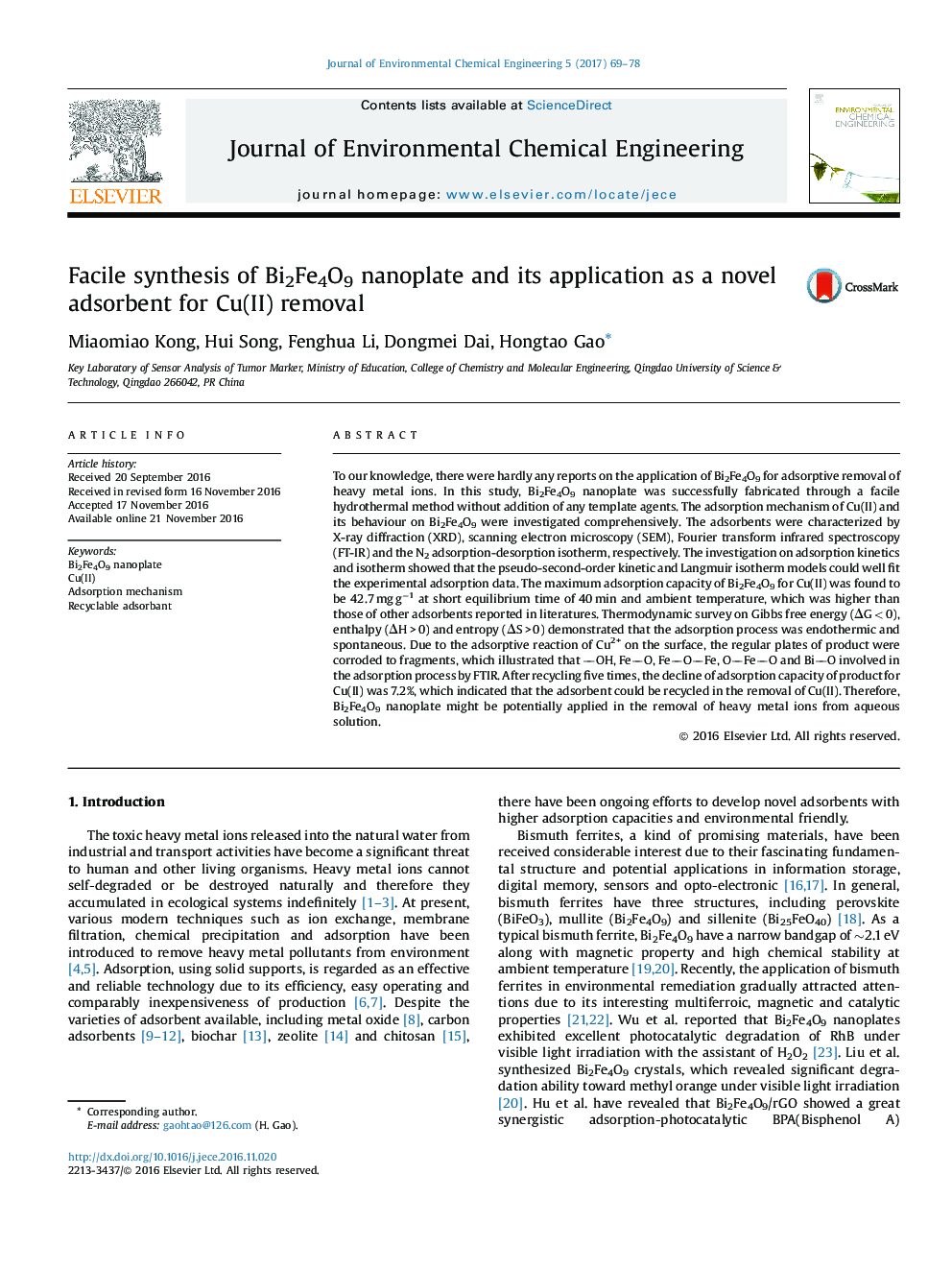| کد مقاله | کد نشریه | سال انتشار | مقاله انگلیسی | نسخه تمام متن |
|---|---|---|---|---|
| 6477266 | 1362584 | 2017 | 10 صفحه PDF | دانلود رایگان |

- It was the first application of Bi2Fe4O9 for adsorptive removal of heavy metal ions.
- The adsorption process was endothermic and spontaneous, which could be well fit by the pseudo-second-order kinetic model.
- The maximum adsorption capacity of Bi2Fe4O9 for Cu(II) was found to be 42.7 mg gâ1, which was higher than those of other absorbents reported in literatures.
- After recycling five times, the decline of adsorption capacity of product for Cu(II) was 7.2%.
To our knowledge, there were hardly any reports on the application of Bi2Fe4O9 for adsorptive removal of heavy metal ions. In this study, Bi2Fe4O9 nanoplate was successfully fabricated through a facile hydrothermal method without addition of any template agents. The adsorption mechanism of Cu(II) and its behaviour on Bi2Fe4O9 were investigated comprehensively. The adsorbents were characterized by X-ray diffraction (XRD), scanning electron microscopy (SEM), Fourier transform infrared spectroscopy (FT-IR) and the N2 adsorption-desorption isotherm, respectively. The investigation on adsorption kinetics and isotherm showed that the pseudo-second-order kinetic and Langmuir isotherm models could well fit the experimental adsorption data. The maximum adsorption capacity of Bi2Fe4O9 for Cu(II) was found to be 42.7 mg gâ1 at short equilibrium time of 40 min and ambient temperature, which was higher than those of other adsorbents reported in literatures. Thermodynamic survey on Gibbs free energy (ÎG < 0), enthalpy (ÎH > 0) and entropy (ÎS > 0) demonstrated that the adsorption process was endothermic and spontaneous. Due to the adsorptive reaction of Cu2+ on the surface, the regular plates of product were corroded to fragments, which illustrated that OH, FeO, FeOFe, OFeO and BiO involved in the adsorption process by FTIR. After recycling five times, the decline of adsorption capacity of product for Cu(II) was 7.2%, which indicated that the adsorbent could be recycled in the removal of Cu(II). Therefore, Bi2Fe4O9 nanoplate might be potentially applied in the removal of heavy metal ions from aqueous solution.
Bi2Fe4O9 nanoplates with highly adsorptive performance were synthesized by a facile hydrothermal method without any template agents and applied for adsorption removal of heavy metal for the first time. The investigation on adsorption kinetics and isotherm showed that the pseudo-second-order kinetic and Langmuir isotherm models could well fit the experimental adsorption data. The maximum adsorption capacity of Bi2Fe4O9 for Cu(II) was found to be 42.7 mg gâ1 in no more than 40 min at ambient temperature. The thermodynamic survey indicated that the adsorption process was endothermic and spontaneous. After recycling five times, the decline of adsorption capacity of product for Cu(II) was 7.2%, which indicated that the adsorbents could be recycled in the removal of Cu(II).172
Journal: Journal of Environmental Chemical Engineering - Volume 5, Issue 1, February 2017, Pages 69-78